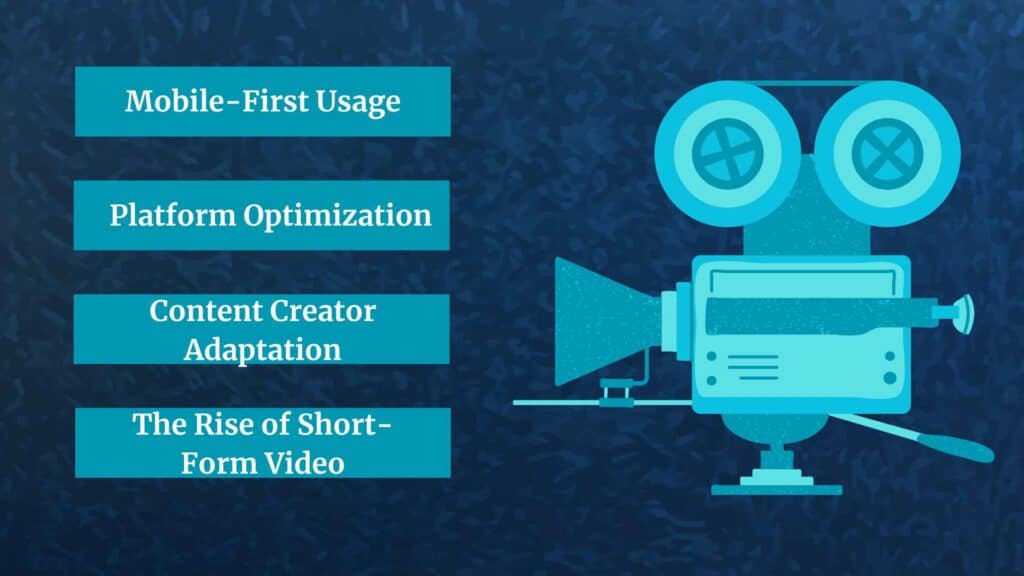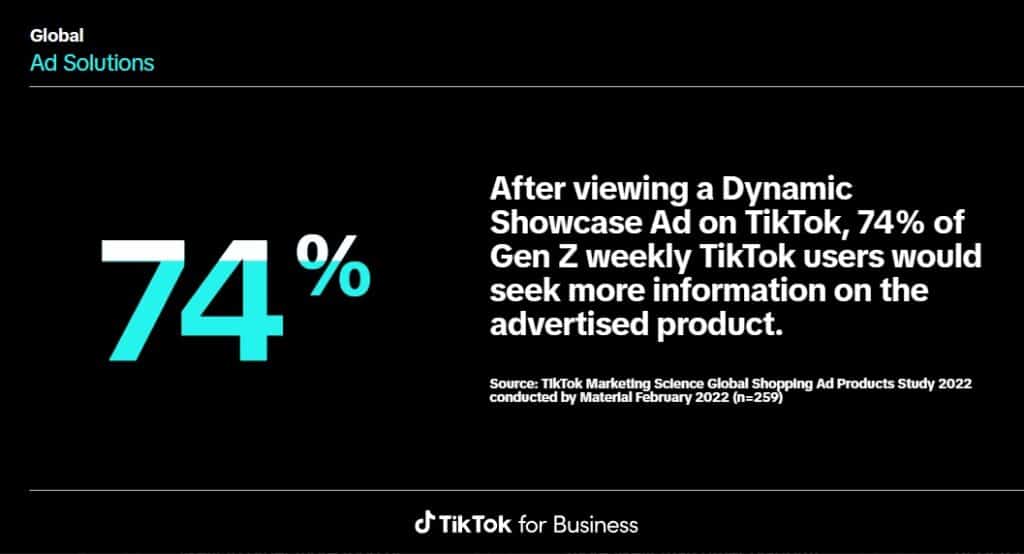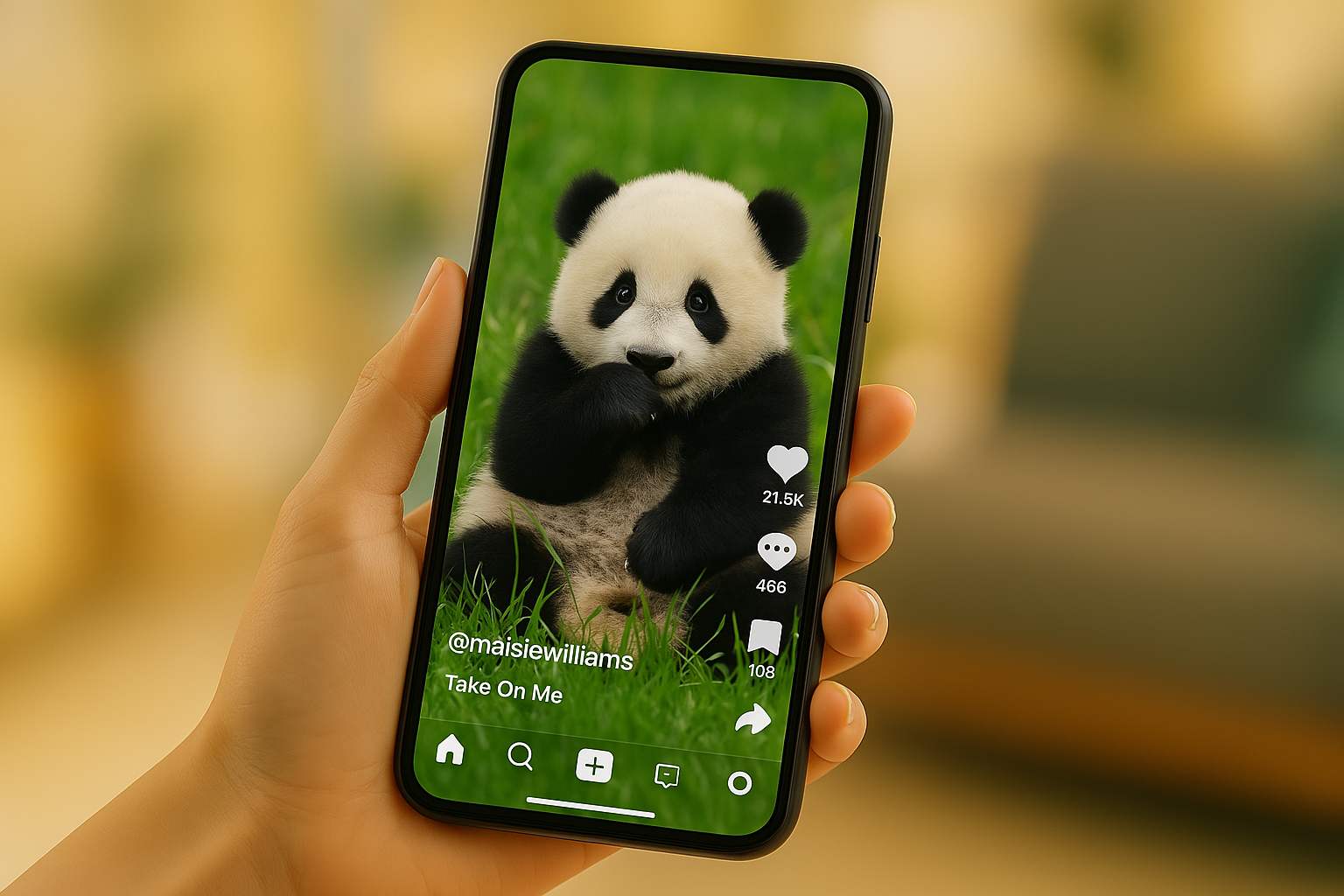Want views?
You better turn that camera upright, buddy. This ain’t 2014.
You only got 3 seconds to hook someone, and no, your cat blinking doesn’t count!
Let’s see how to turn your “meh” content into “how did you do that?!” content.
Let’s face it-
If your content isn’t vertical, it’s practically invisible. In 2025, vertical video for social media isn’t just a trend, it’s the VIP pass to reality.
Whether you are creating:
- Catchy reels
- Snappy Shorts
- TikToks that stop the scroll
The vertical format reigns supreme.
However, here’s the catch! Not all vertical videos are created equal. So before you hit “post” and hope for the best, let’s break down the best practices to help you rise above the noise (and the algorithm).
The Rise of Vertical Video in Social Media
Vertical videos have become very popular in recent years. This trend has changed how we watch videos on social media.
Social media platforms now focus more on vertical videos than the traditional horizontal format. This shift shapes how people create and share content today.
They are influencing:
- User interaction
- Content production
- Even platform architecture
A study says that short-form video delivers the highest ROI compared to other marketing trends.
Analyzing the Paradigm Shift: From Horizontal to Vertical
Vertical video’s dominance is the result of multiple overlapping factors rather than a random occurrence:

Mobile-First Usage
Most people who use social media do so through their smartphones.
The most comfortable and natural way to hold a phone for one-handed scrolling and interaction is vertically. There is no need to rotate the device because vertical video fits this behavior smoothly.
Platform Optimization
Vertical video formats have been extensively adopted and given priority by social media sites.
To make it simpler for both makers and watchers, they have created:
- User interfaces
- Algorithms
- Creation tools
Relatable Read: 25 Best Marketing YouTube Channels To Follow In 2025
Full-Screen Immersion
Horizontal films often have black bars at the top and bottom. In contrast, vertical videos use the whole smartphone screen. This makes the viewing experience more engaging and immersive.
Native Integration
Its popularity has been further boosted by features like swiping up for the next video, integrated editing tools that are tailored for vertical formats. It also feeds specifically for short-form vertical material (like TikTok’s “For You” page).
Content Creator Adaptation
Creators have been changing their tactics more and more as a result of the platform’s demand for vertical content and the high engagement rates. Now, they are:
- Video recording in a vertical position.
- Cropping and altering the current horizontal information to make it more suited for vertical screens.
- Creating material especially suited to the brief, fast-paced format that is frequently connected to vertical video.
The Rise of Short-Form Video
Short, eye-catching video material has become more popular thanks to platforms like TikTok, and the vertical format is a great fit for it.

The popularity of vertical video has been further cemented as a result of this trend. It has encouraged other platforms to implement comparable capabilities.
Crafting Engaging Vertical Content
Making short-form videos needs a different plan than making regular horizontal videos. These platforms move fast. So, you must catch attention quickly and share value right away.
Capturing Attention in the First Few Seconds
On sites like YouTube Shorts, Instagram Reels, and TikTok, viewers scroll quickly. You have only a few seconds to grab their attention and keep them from leaving.
- Make use of striking images: Start with striking pictures, vivid hues, or captivating designs.
- Start with hooks: Strong hooks include asking a question, stating something unexpected, or hinting at the information that will be presented.
- Make use of fast pacing: Quick cuts, dynamic transitions, and captivating motion graphics are all examples of fast pacing.
- Strong audio: Make use of popular sounds, enticing tunes, or lucid and engrossing storytelling.
Relatable Read: A Guide To Managing YouTube Shorts Time Limit
The Power of Storytelling in Short Formats
Even if short-form video is brief, storytelling may still be quite powerful. Brief stories have the power to arouse feelings, transmit knowledge, and make an impression that lasts.
Relatable Read: Storytelling Techniques For Video Production: 10 Methods For Maintaining Audience Attention
Technical Best Practices for High-Quality Videos

Technical best practices must be thoroughly understood to produce captivating videos that draw in and hold the interest of viewers.
You can greatly improve the quality of your video material by paying attention to the basics of:
- Lighting
- Sound
- Framing
- Composition
- Editing
Optimal Lighting and Sound
Your video’s audio and visual components are essential to creating a polished and captivating viewing experience. Ignoring either can seriously undermine your message.
Lighting
Natural Lighting is Your Friend
Use natural light whenever possible. For soft and nice lighting, put yourself or your subject in front of a window. Don’t place the light behind your subject, or you’ll create a silhouette.

Artificial Lighting Considerations
Use artificial light if you don’t have natural light. Ring lights or softboxes can give even, soft light. Keep the lighting steady to avoid distracting brightness changes during your recording.
Minimize Shadows
Look at the shadows on your subject’s face or other important parts of the shot. You can reduce harsh shadows by moving the subject or changing the light position.
Sound
Clear Audio is Non-Negotiable
Poor audio quality often turns viewers away. Try to use a good external microphone, like a shotgun or lavalier mic. If you’re in a quiet place, even a smartphone’s built-in mic can work well.
Minimize Background Noise
Select a peaceful setting for the recording. Switch off appliances, turn off alerts, and pay attention to any reverberation or echoes in the room. If needed, think about utilizing acoustic treatments like foam panels or blankets.
Monitor Your Audio
Before recording your primary content, always check your audio levels. Make sure your voice is clear and loud enough by listening back.
Relatable Read: The 10 Most Effective Types Of Video Advertising To Grow Your Audience
Framing and Composition
Your video’s visual appeal and narrative are greatly influenced by the way you frame your shot and arrange its components.
Understanding Framing
The amount of your subject and the surrounding area that is visible in the picture is known as framing. To communicate various feelings and information, think about using close-up, mid, and wide shots.
The Rule Of Thirds
One essential compositional guideline is the rule of thirds.
Use two horizontal and two vertical lines to divide your vertical frame into nine equal parts. Place your subject or main objects along these lines or where they cross. This often creates a more balanced and better-looking composition.
Leading Lines and Visual Flow
To direct the viewer’s attention to your subject or a particular point of focus, use either natural or manufactured lines in your scene. This can add visual intrigue and depth.
Headroom and Noseroom
A person should have enough headroom (space over their head) and noseroom (space in the direction they are looking) when being framed. Don’t take off the top of their head or make them look confined in the picture.
Editing Tools and Techniques
In post-production editing, you polish your unprocessed video, improve its quality, and provide a smooth result.
User-Friendly Editing Apps for Vertical Video
Many desktop and smartphone apps are made especially for editing vertical video formats, which are common on websites like YouTube Shorts, Instagram Reels, and TikTok. Here are some suggestions:
- InShot
- CapCut
- VN Video Editor
- Adobe Premiere Rush
- FilmoraGO
Essential Editing Techiques
Cutting and trimming
Remove irrelevant materials. Improve pacing and provide smooth transitions between segments.
Including Text and Graphics
To draw attention to important details, provide context, or produce captivating images, use text overlays. To increase visual attention, use animations and graphics.
Music and Sound Effects
Choose sound effects and music that are royalty-free, fit the mood of your video, and improve the viewing experience. Make sure the audio levels are the same.
Color correction and grading
Modify your video’s color, contrast, and brightness to create a unified and eye-catching appearance.
Aspect Ratio Optimization
Make sure your finished video is exported with the appropriate vertical aspect ratio for the platform you intend to use, which is usually 9:16.
Relatable Read: Film Clapperboard: Your Essential Tool For Professional Video Production
Leveraging Trends and Challenges
Staying ahead in the ever-changing social media ecosystem frequently needs
- Proactively interacting with popular trends
- Ingeniously overcoming platform-specific obstacles
Brands and people can greatly expand their reach and develop closer relationships with their audience by comprehending and utilizing these factors.
Participating in Viral Trends
Viral trends are short-lived bursts of increased visibility on social media. These can include popular meme formats and recurrent hashtag campaigns on Twitter and Instagram, as well as particular audio samples and dance moves on sites like TikTok.
Tip: Keep an eye on popular content formats, hashtags, and hot subjects on the platforms that are relevant to your target audience.
Creating Platform Challenges
Brands and individuals can create their own platform-specific challenges instead of just following trends. These challenges often encourage users to create content. This builds a sense of community and increases engagement.
Relatable Read: Wistia Vs. Vimeo: Pros, Cons, And Which Platform Wins For Businesses
Accessibility and Inclusivity Considerations
In addition to being morally right, producing inclusive and accessible content is strategically necessary to increase reach and engagement.
Content producers can reach a larger audience and create a more uplifting and inviting online community by considering the demands of various consumers.
Adding Captions and Subtitles
Social media platforms are now dominated by video content. However, without textual help, it may be difficult for people with hearing impairments or those who prefer to consume content without audio (such as in public places) to understand the message.
Tip: Make sure all video content has appropriate captions and subtitles to make it accessible to a larger audience. As a result, it includes people who are hard of hearing.
Visual Clarity and Text Size
On social media, visuals help grab attention and share information. But poorly designed images can leave out people with visual impairments or those using small screens.
- Consider a split screen
- Provide instances of larger, highly contrasted font overlays (white text on a black backdrop, for example) that are nevertheless readable on smaller mobile devices
Relatable Read: The Ultimate Guide To E-Commerce Video Marketing In 2025
Analyzing Performance and Iterating
To get the most out of vertical videos, you need to use a data-driven approach. Track performance regularly and adjust your strategy based on new data. This helps you improve and reach more people.
Key Metrics to Monitor
You need to track specific metrics on different platforms to see how well your vertical video content connects with your audience.
| Metric | Description | Importance |
| Watch Time | The average time viewers spend watching your video. | Important for the video platform algorithmsIndicates content engagement and ability to maintain attention |
| Engagement Rate | The percentage of viewers who interact with your video | Reflects how active your audience is with your content and can signal content quality and relevance. |
| Shares | The number of times viewers share your video with others. | Highlights content virality and its ability to connect beyond your immediate audience. |
| Reach | The total number of users who saw your video. | Reflects the breadth of your content’s distribution. |
| Impressions | The number of times your video was shown to users. | Represents the potential audience exposure. |
| Click-Through Rate (CTR) | The percentage of viewers who click on a link or call-to-action within your video. | Measures the effectiveness of your video. |
A/B Testing Content Variations
You should use A/B testing to test different parts of your vertical video content. This helps you improve its performance over time.
Experiment with different hooks
The first few seconds of a video are very important for grabbing attention. Test different opening lines, images, or sound effects to see which ones get the most views and engagement.
For example, start one video with a question and another with a surprising statement.
Explore diverse formats
No one style applies to vertical video. Try a variety of content to see what works best for your audience, such as
- Product demos
- Behind-the-scenes looks
- Storytelling narratives and tutorials
Optimize posting times
Check when your audience is most active to find the best times to post. Look at their age, location, and online habits to get better visibility and engagement.

[Source: Zebracat]
Peak activity hours can vary among platforms and audience segments. Use platform analytics to find out when your followers are most active.
Vary the video length
Test different types of content to see what your audience likes. Try short, quick videos and also longer, more detailed ones. A full explanation might take a few minutes, but short tips can work well in just fifteen seconds.
Test different calls-to-action
Change the wording and placement of your call to action to see what gets the most clicks. Try phrases like ‘Learn More,’ ‘Shop Now,’ and ‘Swipe Up for Details’ to find out which one works best.
Future Trends in Vertical Video Content
Due to the shifting consumer expectations and technology breakthroughs, the vertical video sector is always changing.
Augmented Reality (AR) Filters
Vertical video platforms are increasingly using AR filters. These superimpose digital components on the actual world. By enabling
- Gamification
- Creative self-expression
- Interactive experiences
These filters can improve user engagement. Consider interacting with a brand’s mascot in a vertical video or putting on makeup virtually.
Interactive Videos
Viewers can now interact with content in more dynamic ways due to the increasing interactivity of vertical videos. Some examples of this are:
- Polls
- Tests
- Branching stories that let viewers pick their path
AI-Powered Editing and Personalization
The future of vertical video production and viewing is probably going to be heavily influenced by artificial intelligence.
AI systems may tailor video feeds to user preferences, automate editing procedures, and recommend the best content formats based on user data.
Relatable Read: How AI Is Transforming The Video Production Industry
Wrap Up!
Get ready to take your vertical game to the next level. Let LocalEyes help you create high-impact, scroll-stopping content that speaks to your audience and offers results! Let’s go vertical-together!
Frequently Asked Questions (FAQs)
What resolution and aspect ratio are best for social media vertical videos?
For the best full-screen viewing on mobile devices, a 9:16 aspect ratio and 1080×1920 pixel resolution are advised.
In 2025, how long should my vertical videos be to get the most engagement?
Aim for brief videos that are between 15 and 60 seconds in order to keep viewers’ interest to get the most engagement.
Why is sound so important for vertical video content on sites like Reels and TikTok?
Given that many viewers first watch without sound but will switch it on if the content is appealing, audio, including popular music and clear narration, significantly improves engagement and discoverability.
What are some essential tactics to boost my vertical videos’ interactivity and viewership?
Start with an attention-grabbing hook, tell a tale, incorporate accessible subtitles, make your content mobile-friendly, and leverage popular noises and niche-related topics.
Should I always record movies for TikTok, Reels, and Shorts in a vertical orientation?
Indeed, shooting vertically improves content performance by avoiding unpleasant black bars or the necessity for viewers to rotate their phones, which guarantees the optimum watching experience on mobile devices.

Executive Producer at LocalEyes Video Production | Emmy Award Winning Producer



